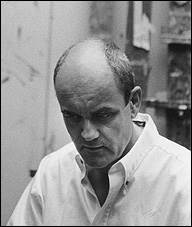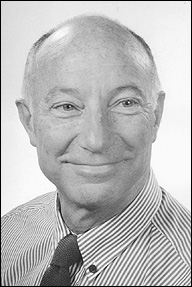![]()
Departments
Arts
![]()

|
Week of 13 November 1998 |
Vol. II, No. 14 |
Arts
Photonics plays Medici to BU artists
By J. Nicole Long
"When I make an image," says Hugh O'Donnell, "I am growing something."
First Light, a sculpture by the artist and SFA professor, is one of a series of digital images known as Instrumental Variations on a Theme in Dylan Thomas, which pays homage to the poet's work. "It started as an idea of a plant that gives off its own light," he says, "a kind of inverse photosynthesis." This Photonics Center project is the latest in a series of cite-specific architectural projects SFA has been organizing at BU.
O'Donnell used photonics technology, a new medium for artists, to create the image. A computer file was transferred to transparency film using a digital laser printer. The film is positioned behind glass and illuminated from behind by fluorescent lights. First Light is a 12' x 14' installation window commissioned by the Photonics Center and will be formally unveiled during a ceremony on November 13.
|
|
|
Hugh O'Donnell |
First Light refers to Thomas' poem "The Force That Through the Green Fuse Drives the Flower." But O'Donnell is not illustrating Thomas' poems. "I'm asking people to consider the poetic notion of illumination as opposed to the literal fact of light," he says. "I'm interested in the apprehension of a force that can't be pointed to &emdash; when you awaken to it, it awakens in you."
The art of poetry and vice versa
Aware of the boundaries between, and the confluences of,
science, religious doctrine, and the practice of art,
O'Donnell says his art is akin to the nature of poetry.
"Religious thought is poetic in nature; it describes things
we can't see and measure," he says. "Science is precisely
about empirically measuring and proving the objective world.
And religious thought can be divisive. Poetry doesn't do
that; poetry, and art making, are not as much about belief
as they are about the exercise and practice of intuitive
sensibilities."
Literally drawn in light, First Light was created by using a mouse stylus and Photoshop software, and the computer filtered the light without interference by O'Donnell. He made no attempt to simulate the effect of a brush on canvas. Rather than intending his image to look like a painting, he says, "in this work, I am a painter interested in the instrument. I wanted the computer's part in the process to be clearly recognizable." According to O'Donnell, it is possible to use and celebrate new technologies without overglamorizing them.
Shawn Burke, deputy director of the Photonics Center, says that the reason to celebrate photonics in particular is because of its interdisciplinary nature. Chemistry, physics, and electrical engineering are examples of the disciplines that most often work together using photonics. Burke and Donald Fraser, director of the Photonics Center, say they are enthusiastic about continuing the collaboration between art and science at BU. The Photonics Center is interested in supporting not only established artists, but students as well.
Graduate student Robert Smart (SFA'99), who has also done an installation for the Photonics Center, says that working outside of the art department has required some assistance. He has relied on the help of SFA Assistant Professors Carol Keller and Kitty Wales in both aesthetic and practical matters &emdash; in making decisions about his sculpture and communicating his needs to the Photonics Center.
Although he's most comfortable using traditional technologies such as paint brushes and metal nibs, Smart says, he feels compelled to use contemporary technologies. "I feel some pressure to compete with the television," he says. "Everyone's so steeped in moving images and loud sounds. But this project has raised a conflict in me. The object I imagined is being built, but a lot of it is out of my hands and in the computer. It's a very different kind of participation in a project, but I'm learning a lot about the technology &emdash; and a lot about how to communicate with Mike."
Mike Lewis (ENG'00) has spent hundreds of hours with Smart developing the computer system that, among other things, regulates the variation in the colors of Smart's sculpture. "I'm trying to translate his ideas into a program," says Lewis. "It's challenging, but I try to do things to make it easier, such as being attentive to the way Rob needs the image of the sculpture on the computer screen to correspond with the real visual field."
The skin you love to play
"When it's done," says Smart, "the sculpture will interact
with smart skin [a new technology that has been described as
a hearing aid for skin]. People can play the smart skin like
a musical instrument, and when no one plays it, the colored
light will respond to the movement, rhythm, and time of
traffic patterns inside the building."
In the distant past, artists relied on religion or the nobility for patronage, O'Donnell says, but they might now look to science. O'Donnell has declined payment for First Light. "Rather than take money," he says, "I asked Don Fraser to establish a student award. This will, hopefully, encourage him to commission students on an ongoing basis."
In addition to Smart's sculpture, work by students Lee Kasai (SFA'98) and Alice Orleman (SFA'99) will also be on view during the opening.
Festival will explore Bach's music in its proper setting
By J. Nicole Long
Boston University is putting Bach back where he belongs: in church.
The Bach Festival: Kirchenmusik, which runs from November 20 through 22, takes the music of Johann Sebastian Bach (1685&endash;1750) out of the concert hall and returns it to the setting for which most of it was written. (The Festival's subtitle, Kirchenmusik, means "church music.") In addition to a series of concerts and a master class for vocalists, the Festival will include symposia and religious components.
|
|
|
Max van Egmond
Photo by Foto Studio
Heno
|
At the center of the celebration are two performances of Bach's Christmas Oratorio (Weihnachts-Oratorium), BWV 248, written in 1734. A substantial undertaking, the Oratorio requires a large orchestra for a baroque work. (The brass ensemble will be led by one of North America's most distinguished exponents of the natural trumpet, John Thiesse.)
A cast of distinguished Boston-based soloists, soprano Anne Harley, contralto Elizabeth Anker, and tenors Robert Pitcher and Thomas Gregg, will be joined for both performances by the legendary Dutch baritone Max van Egmond, who achieved his greatest fame as an interpreter of Bach's cantatas, masses, and passions.
"For 30 years Egmond participated in the recording and performance of Bach's complete choral works with conductors Gustav Leonhardt, Nikolaus Harnoncourt, and Frans Bruggen," says Julian Wachner, University organist and choir director and STH assistant professor. Egmond has received, among many awards and honors, a special decoration from Queen Beatrix of the Netherlands for 40 years of service to Dutch musical life. "Egmond," says Thornburg, "is to Bach oratorio performance what Michael Jordan is to basketball."
That Wachner will conduct the Oratorio is only fitting. He is, after all, BU's own Kapellmeister. Wachner says that he has wanted to emulate Bach since the age of six. "And since this past summer, I've been living and breathing Bach's world of sound," he says. "I study it, listen to it, play it, and I'm teaching a Bach class this semester. Recently, not a day goes by without him &emdash; but the feeling of conducting the Oratorio is awesome, in the truest sense."
The festival will offer audiences the opportunity to hear Bach, the quintessential church composer, in the appropriate ecclesiastical setting, with period instruments and vocal soloists known for their historically accurate performance.
Among the Bach Festival: Kirchenmusik events, the Christmas Oratorio will be performed on Friday and Saturday, November 20 and 21, at 7:30 p.m. Cost is $20 for general admission and $50 for patrons. On Sunday, November 22, there will be a service at 10:45 a.m. in Marsh Chapel, with a performance of the cantata Gott der Herr ist Sonn und Schild, BWV 79, from 1725. For more information about these and other Bach Festival events, call Marsh Chapel at 353-3560.

